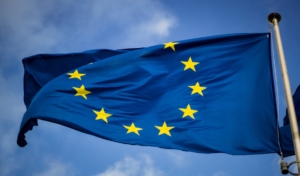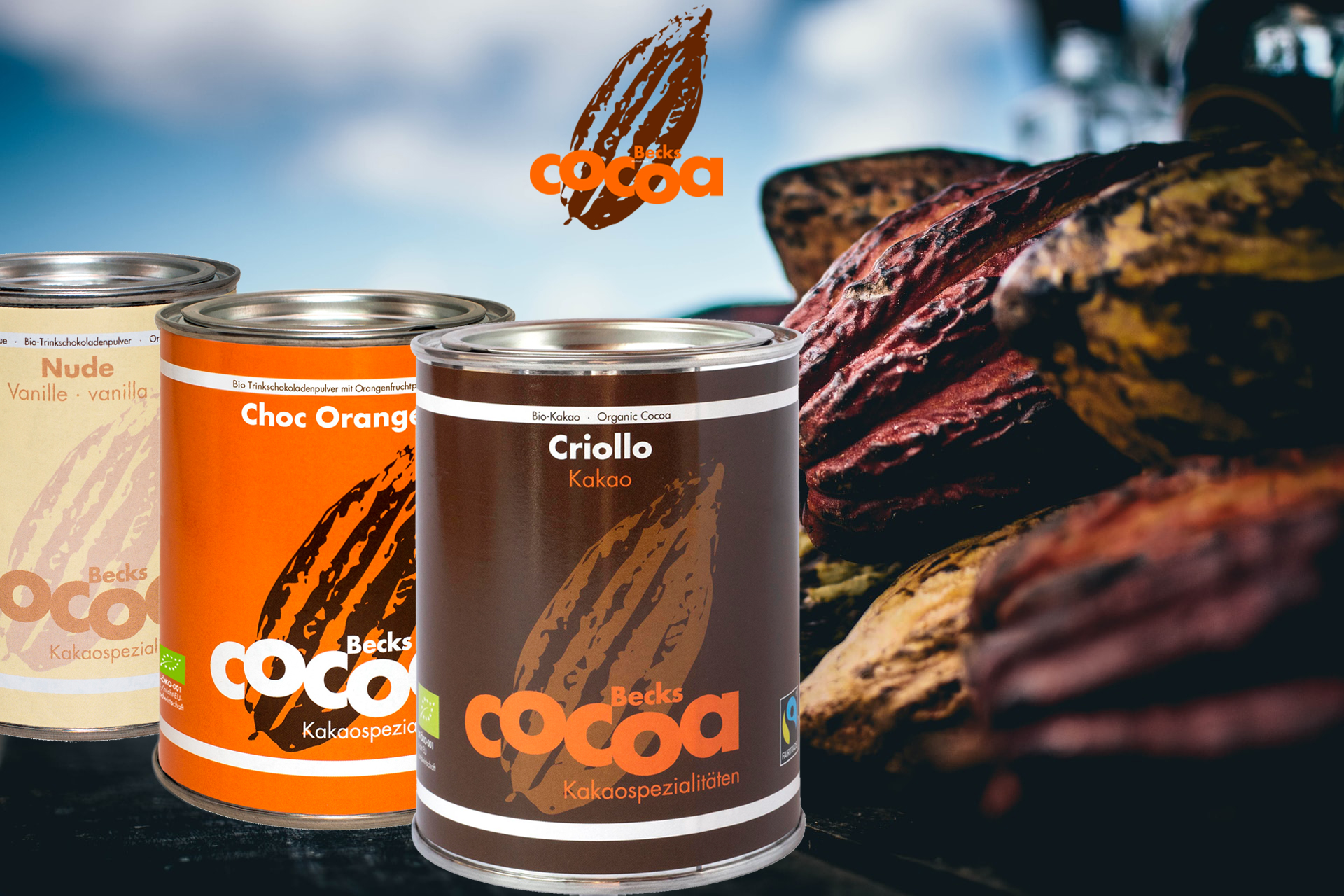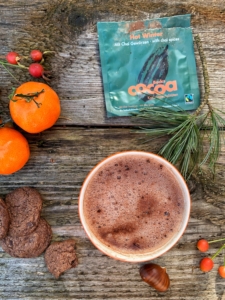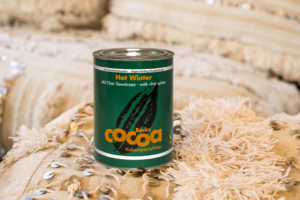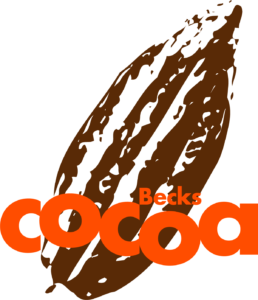I come from Europe! I can tell you, there’s becks-cocoa everywhere!
Did you know where our Becks Cocoa cocoas are drunk in our neighbouring countries? You’ll be surprised at the varieties! And what we do with them at Christmas time …
Tastes differ, as the saying goes. And so are traditions and customs. This is true from region to region, and especially from country to country. So it is all the more surprising that the same four of our fine flavoured cocoas are the favourite drinks in such different European countries: Poland, Hungary, Sweden, Denmark, Great Britain and the Baltic countries Estonia, Lithuania and Latvia!
These 4 cocoas are loved and drunk all over Europe
The four classics that are most bought here in Germany are also the favourite cocoas in the countries listed above:
- CRIOLLO
Simply 100 percent best cocoa, tart, refined without sugar and without additives: a piece of Central America to enjoy! - THE FUDGE
Fine cocoa with cream caramel. Lovely in taste; with a softness that taste enthusiasts call “mouthfeel”. It elicits a “umpff” from children! - CHOC ORANGE
Fine cocoa, subtly composed with the taste of sun-ripened oranges and a hint of ginger. A very early variety and as popular as ever! - NUDE
Strong chocolate flavour meets sweet vanilla from Madagascar. A wonderful combination!
Only drunk? Or also cooked and baked! – A culinary journey
We love cocoa! – And always. At all times of the day, in all seasons, in all varieties and variations. Cold, hot, in summer, in winter, in a cup, in a glass, in a cake, on bread, in a saucepan, in a dough bowl and in the oven! And especially now at Christmas time – the classic “hot chocolate” time. So it is naturally a pleasure for us to explore and taste which typical dishes our four classics – CRIOLLO, THE FUDGE, CHOC ORANGE and NUDE (and because we are not dogmatic, we also let one or two of our cocoas shine) – go with Advent, Christmas and holiday dishes in our European neighbouring countries!
“Wesołych Świąt!” – Merry Christmas with Becks Cocoa in Poland
Quite different from here in Germany, the Advent season in Poland is a time of fasting! That’s why there are twelve Lenten dishes* on the table at Christmas. Wigilia is the name of the Christmas custom. The preparations for the extensive feast sometimes begin days before.
The food is meatless, but there is a lot of fish! For example, matjes herring in cream sauce. Carp also has a long tradition; it is classically served breaded or in jelly. Other common dishes include potato salad with peas, carrots, celery, eggs and pickles, pirogues, croquettes filled with sauerkraut and mushrooms, breaded mushrooms and stuffed hard-boiled eggs. The seasoning on the side is beetroot and horseradish.
The obligatory beetroot soup – which is served first in many Polish families and into which we cocoa lovers naturally add a pinch of our BEET ME UP! to taste – includes the homemade uszka dumplings (the “little ears” that look like tortellini), also filled with sauerkraut and mushrooms. The second starter, a bean soup, is of course not to be missed.
For sweets, most tables have poppy seed stollen (we mix some AMYDALA into its dough because we find poppy seeds and marzipan aroma indescribably good!) and kutja, a cereal dessert with hulled wheat, poppy seeds, honey, nuts and dried fruit. On top of the kutja in our little bowl, we sprinkle some CHOC ORANGE to match the candied orange peel mixed in and as the icing on the cake.
*By the way, the number twelve refers to the twelve apostles and the twelve months of the year.
“Linksmų Kalėdų!” – Merry Christmas with Becks Cocoa in Lithuania.
On festive occasions, the Lithuanian branch cake Šakotis is a must, especially for weddings and birthdays. We already wrote something about this in our first “Hello Europe!” article. The branch cake is also popular in Poland, where it is called Sękacz! Colloquially, the elaborate layer cake is also called bankuchenas – tree cake. It is made with a lot of eggs, butter, sugar or honey and sour cream. With its spikes and prickles on the side, which are created by making it on a skewer, it reminds us of a Christmas tree. But to make it so jagged and spiky, you need a very special oven. We don’t have one. So we take the Bankuchenas inspiration and use Lithuanian ingredients to bake a tree cake that is very popular in this country around Advent: a little ground cardamom and a cinnamon-marzipan-cocoa mixture from Becks Cocoa Kakaos SINNERMAN FORTE and AMYDALA in the dough give it a wintery-Christmas aroma.
A traditional Lithuanian pastry baked on 23 or 24 December is Kūčiukai (also: Prėskučiai or Šližikai). The base is yeast dough and poppy seeds. The thumb-tip-sized biscuits are hardly sweetened, are quite hard and are crunched by young and old as an appetiser or dessert. For a kind of milk soup, you can also put them in poppy seed milk – Lithuanian style – which is prepared the day before: Simply pour boiling water or boiling milk over the poppy seeds and let them steep overnight. By the way, the Kūčiukai can be kept for a very long time and are a popular winter snack in Lithuania even after Christmas Eve.
Another typical sweet is called Sūrelis Nykštukas or Varškės Sūrelis. It is also popular in Estonia, Latvia, Ukraine and Russia. The filling, usually coated in chocolate, consists of squeezed sweet curd cheese cut into candy-sized pieces. Today, you can buy the sweets in all kinds of varieties – by the gram, by the kilo and by the bag – in almost every supermarket. But they taste best when homemade! Classically, the filling is flavoured with vanilla. Of course, our NUDE cocoa is the perfect refinement. Other ingredients such as jam, nuts and sultanas are also added to the quark. Here you can simply play around and try it out. For example, how does the creamy caramel THE FUDGE or our CRIOLLO go with the filling? The BEET ME UP would also be exciting, because instead of chocolate, the Sūrelis sweets are also available with a fruity or vanilla coating.
“Веселих свят!” (pronounced: Weselich Swjat!) – Merry Christmas with Becks Cocoa in Ukraine.
Similar to Poland, the pre-Christmas period in Ukraine is Lent. Here, too, twelve Lenten dishes are served at Christmas (without meat or dairy products!) – a reference to the 12 apostles. According to the rules, no alcohol is to be drunk at the Lenten meal on Christmas Eve. Many Ukrainians, however, do not take it so seriously after the long period of deprivation and like to raise a glass together at Christmas.
As in Poland, fish is allowed. Herring or pike are often on the menu. Other common dishes are pancakes (Berliner), vareniki with potato filling and – very important – a vegetarian borscht with small dumplings (in Ukrainian they are also called “little ears” as in Poland) or other dishes with beetroot. Wherever it fits well, we refine them with our spicy beetroot BEET ME UP!
The most important dish of the 12 Ukrainian Lenten dishes is kutya, which is prepared and eaten according to a similar recipe as in Poland (see above!), Russia, Belarus and Lithuania (and over which we still prefer to sprinkle our fine cocoa AMYDALA!). This dessert consists of cooked wheat grains, poppy seeds, honey and, depending on family tradition, sultanas and/or nuts. On Ukrainian Christmas Eve, kutya is traditionally served first. According to custom, everyone in the family should eat at least one spoonful. It is said that the head of the family can tell from the consistency of the cereal dish how the coming year will be …
We would like to tell you about another very beautiful Ukrainian Christmas ritual: Traditionally, an empty plate with cutlery is placed in one of the windows of the dwelling. This is so that the ancestors of the family can take part in the meal. In this way, many Ukrainians remember their deceased relatives at the dark time of year. We add a spoonful of cocoa.
“God jul!” – Merry Christmas with Becks Cocoa in Sweden
Julbord is what the Swedes call their full Christmas table: with lots of different fish, cold dishes like eggs, roast beef and beetroot salad, plus bread, cheese, sausages, köttbullar, cabbage and most importantly: Christmas ham, which must not be missing! Finally, there is Ris a la Malte, a kind of cream rice pudding with fruit, usually with orange fillets (we sprinkle CHOC ORANGE, NUDE or SINNERMAN on top, depending on taste and mood), Knäck (cream sweets with almond slivers, In our opinion, Becks Cocoa THE FUDGE or our CHOC ORANGE go best with it) or ice chocolate (you can top it with all cocoas from Becks Cocoa in the truest sense of the word): topping).
A very popular spice for the (pre)Christmas season is saffron! Nuts and fruits such as oranges, figs and dates are also associated with Christmas in Sweden: Why not serve your guests fresh, half-sliced Medjool dates with Advent coffee, sprinkle them with a pinch of T.E. LAWRENCE on the inside, fill each with an almond and finally dip them halfway into the cocoa powder. You can also roll them completely in cocoa powder.
Glowing wine – with cocoa!
A well-known Scandinavian speciality is glögg, a kind of mulled wine with almonds and berries. It is usually served in small cups. In general, mulled wine variants are drunk in many European countries during the cold season and Advent. In Poland, for example, a much sweeter variation of the mulled wine drunk here is popular, called Grzaniec Galicyjski and flavoured with honey. Hungarian Forralt bor is often prepared over an open fire in a cauldron. It is made with light, dry red wine, cinnamon sticks, orange slices and only a little sugar. If you like the Hungarian mulled wine with a shot enjoyed at Christmas markets, sledding or ice skating, add some pálinka (fruit brandy).
We at Becks Cocoa have a special inspiration for you: mulled wine with spiced fine cocoa! Sascha and Torsten from Die Jungs kochen und backen have developed a chocolate mulled wine recipe this winter with our NUDE, which goes wonderfully with biscuits and an Advent afternoon! Try it!
“Čestit Božić!” – Merry Christmas with Becks Cocoa in Hungary
One ingredient that is rarely missing from Hungarian Christmas cuisine? Poppy seeds, poppy seeds, poppy seeds! The most typical Christmas treat is the beigel (bejgli), a dough roll filled with poppy seeds or nuts. Classically, the rolls are made from a dough with flour, lard, butter, icing sugar, milk, egg, yeast and a pinch of salt. The filling is made with ground poppy seeds or ground walnuts, icing sugar, honey, sultanas, lemon zest, milk, candied orange peel, vanilla and sugar. It is important that the pastry is nice and moist! The roll with poppy seeds is called Mákos beigli in Hungarian, the one with nuts Diós beigli.
Mákos guba, a dish similar to the Christmas Silesian poppy seed dumplings, are also refined with poppy seeds. To make them, soak cut-up kifli (croissants) in milk and sprinkle them with a mixture of washed and then scalded poppy seeds and icing sugar. We recommend adding a pinch of CHOC ORANGE, SINNERMAN or NUDE on top. You can serve orange or apricot jam, honey or vanilla sauce with the Guba.
A pastry for all kinds of celebrations – baptism, wedding, communion – is Kürtőskalács, or tree striezel or chimney cake! You’ll find them at every Christmas market or folk festival in Hungary. The dough consists of flour, yeast, sugar, eggs, milk, butter, salt and, depending on taste, almonds, nuts or poppy seeds. It is rolled out thinly onto thick, round wooden moulds (usually made of maple wood) and baked over open embers. Before eating, you can sprinkle it with cinnamon and walnuts. All we can say is: try SINNERMAN FORTE with the walnuts!
The famous Hungarian New Year’s Eve punch Krampampuli is a kind of fire punch, made from white wine, black tea, rum or the fruit brandy Pálinka, orange, lemon, sugar, cinnamon, cloves, dried fruits, optionally also candied fruits and nuts. In the style of the fine chocolate mulled wine that Sascha and Torsten from Die Jungs backen und kochen developed for us, you can also experiment here with SINNERMAN FORTE or our NUDE.
There is a charming Christmas custom in almost all families in Hungary that we would like to tell you about: On 24 December, the branches of most Christmas trees bend under the szaloncukor (parlour sugar) wrapped in colourful tissue paper or aluminium foil. These are chocolates made all over the country by large manufacturers, but also handmade in small quantities by confectioners. Every year, about 6,000 tonnes are produced and sold in large colourful packages. The most popular fillings have long been jelly, followed by coconut and marzipan. Our partners in Hungary drink a hot cup of CHOC ORANGE or AMYDALA with them.
By the way, the Christmas chocolates don’t stay on the tree for long. By 26 December at the latest, the last seekers will only find the little papers on the unburdened branches. Because the most fun is to peel the sweets out of the wrapping unobserved so that it looks from the outside as if the chocolates are still inside (but they are only the colourful wrappers!) and to eat them secretly.
“Glædelig jul!” – Merry Christmas with Becks Cocoa in Denmark
It starts as early as November, a collective rejoicing: Julefrokost, a festive eating and drinking together. In companies, clubs, restaurants, pubs, with friends, neighbours, members, relatives, colleagues. It permeates all leisure time activities into December. At lunchtime on Christmas Day and Boxing Day, the family gets together again and also celebrates: Julefrokost!
What does it look like? First there is fish, from marinated herring to smoked salmon and shrimps to meatballs and breaded fillet. Then come meat dishes such as warm liver pâté, bacon, meatballs, tartelettes with chicken fricassee, roast goose, duck and pork (with red cabbage, Bavarian: Blaukraut) and of course: Christmas ham! Various vegetables, salads and boiled potatoes or brunede kartofler (caramelised potatoes), a typical Danish speciality, are served as side dishes.
Later, there is a cheese platter. Finally, you eat the almond milk rice risalamande (similar to the French riz à l’amande) for dessert. Whipped cream and chopped almonds are folded into the cold vanilla rice pudding, and cherry or strawberry sauce is added on top. Port wine is drunk with it. Traditionally, the cook hides a skinned almond in one or the other of the desserts. Whoever finds it gets a little present, the almond gave. Our almond gave is a tin of NUDE and optionally one of our sprinkle tins CHOC ORANGE or SINNERMAN. All three go very well with rice pudding.
With all of this, you drink alternately beer (e.g. Christmas brew, the Christmas beer Juleøl or light beer) and Jule aquavit.
A traditional Advent and Christmas biscuit is Æbleskiver (apple slices), which are fried in fat in a Æbleskivepande, a special pan with several round depressions. The little cakes look similar to the North German Förtchen (also: Pförtchen, Futjes, Pfütten) or the South German Krapfen (doughnuts), but are not made with yeast, but with buttermilk, flour, eggs and sugar and flavoured with vanilla, lemon zest or cardamom. Instead of icing sugar as usual, you can sprinkle them with our THE FUDGE (cocoa with cream caramel). Serve with jam. By the way, in Norway the cakes are called munker.
Another confection traditionally eaten at midnight on New Year’s Eve and at large family celebrations such as weddings or christenings is Kransekage (wreath cake). Several different sized rings of raw marzipan, icing sugar and egg whites baked together are layered on top of each other, usually assembled in a cone shape, and then decorated with a icing of icing sugar and egg white in a loop pattern and small paper national flags. We drink a cup of hot AMYDALA with it. The Norwegians know the elaborate cake by the name Kransekake.
Merry Christmas! – Merry Christmas with Becks Cocoa in Great Britain
Very British, of course, is the Christmas pudding (plum pudding): Flour, (beef) fat, sugar, dried fruit, often soaked in high-proof alcohol. Almost every household has a special family recipe. This is the classic in Britain at Christmas. We add a few spoonfuls of CRIOLLO to our dough, which gives the dark pudding, which is a cake, a subtle hint of chocolate.
Another sweet traditional pastry, made of flaky or shortcrust pastry and classically filled with dried fruit, nuts and often a little alcohol, which is baked in English climes at Christmas time and the turn of the year, are mince pies. Santa Claus is said to be particularly fond of these little cakes. That’s why many families put a plate with one or two pieces on it by the fireplace as a thank you to him, where the stockings for the presents hang. In addition, there is a yellow turnip for the hard-working reindeer that pull his sleigh.
By the way, the mince pie filling is especially delicious with our cinnamon cocoa SINNERMAN or SINNERMAN FORTE. That’s sure to please Father Christmas too!
Finally, we have a delicious German-English mélange: the blogger sisters Britta and Swenja from Klara & Ida have taken the traditional German Spitzbuben and spiced them up with our CHOC ORANGE on the theme of “Europe”, made them into dark chocolatey dough and filled them with homemade orange curd in a homage to Great Britain. Wow, so good! Click here for the recipe!
((Picture: Belinda the Baker))
Today we conclude our Europe contribution with one of the Germans’ favourite cakes, the cheesecake: Belinda the Baker has a small café in the Bavarian town of Pressat and has been serving our Becks Cocoa Kakao there for years. She is a passionate baker and photographer and has baked an elaborate cake variation for us, which you can reliably recreate using her recipe and the reel she made for it: Her cheesecake cake is multi-tiered (with three layers!) and made with our fine cocoa THE FUDGE. To kneel down!
If you like our trip to culinary Europe, take a look at our channels on Instagram or Facebook and write us what inspired you the most in our post or what you love to eat on Christmas Eve and refine with our cocoas.
Merry Christmas to you and your loved ones!
Did you know where our Becks Cocoa cocoas are drunk in our neighbouring countries? You’ll be surprised at the varieties! And what we do with them at Christmas time …read more here!
